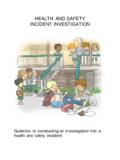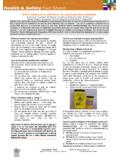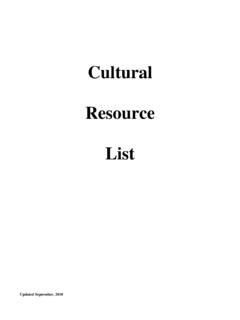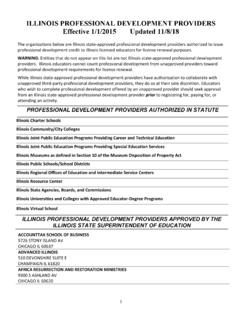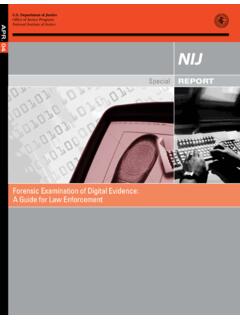Transcription of Working at Heights Guideline - Education
1 Department of Education Organisational Safety and Wellbeing Reviewed October 2018 V1 Uncontrolled when printed Working at Heights Guideline June 2014 Department of Education Organisational Safety and Wellbeing Reviewed October 2018 V1 Uncontrolled when printed Contents 1. Purpose 3 2. Legislation 3 3. Construction work 3 4. What do I have to do to manage fall from Heights risks? 4 5. Responsibilities 5 Principal/Managers 5 Contracting out the task 6 Managing contractors 6 Employees 8 6. Controlling the risk when Working at Heights 9 7. Using and maintaining the right equipment 11 8. Monitor/Review Controls 11 9. Record Keeping 11 10. Training 12 11. Specialised training and licensing 12 12. Useful references 13 13. Definitions 13 Appendix 1: A basic process for managing work at Heights 14 Appendix 2: Selection of equipment linked to the 5 level hierarchy of fall control.
2 15 Department of Education Working at Heights supporting documents Working at Heights inspection tool Working at Heights risk assessment template Safe Work Method Statement (SWMS) template Creating Healthier Workplaces - Working at Heights - including a range of SOPs Department of Education Organisational Safety and Wellbeing Reviewed October 2018 V1 Uncontrolled when printed Working at Heights 1. Purpose This Guideline is about managing fall hazards. A fall hazard is: a situation where a person is exposed to a risk of a fall from one level to another that is reasonably likely to cause an injury. Even falls from a low height have the potential to cause serious injury and must be managed. a falling object. These can cause serious injuries if controls are not implemented to eliminate or minimise the associated risks.
3 A person can receive fatal head injuries if an unsecured object is dropped from a height . It is essential to ensure that objects do not fall onto people who may be under or next to the area where the work is being carried out. This Guideline provides information to assist workplaces to manage fall hazards in the workplace which includes activities where people are Working : off the ground ( up ladders, on work platforms) on the ground close to holes ( excavations) edges or ledges ( retaining walls) openings through which people could fall ( skylight) or in areas where objects may fall from higher levels and cause injury. 2. Legislation Part of the Work Health and Safety Regulation 2011 (Qld) has specific requirements regarding the management of fall hazards.
4 These requirements must be implemented by workplaces. The Regulation does not differentiate between height distances (R78). Requirements apply to all fall hazards from one level to another, regardless of the distance from the ground, including the use of low level platforms and ladders. The Regulation provides a five level hierarchy of control that stipulates the options to manage fall hazards (R79). The hierarchy begins with the level 1 control elimination - the most effective hazard control strategy. A lower order control ( level 4 or 5) can only be used when it is not reasonably practicable to use a higher one. The fall from Heights hierarchy of control is: Level 1: Eliminate the hazard by performing the work on the ground or on a solid construction.
5 Level 2: Use a passive fall prevention device; edge protection which prevents falls. Level 3: Use a work positioning system; which limits movement and therefore minimises access to areas where a fall can occur. Level 4: Use a fall arrest system a harness, which does not eliminate a fall, it only prevents the person falling to the ground. Level 5: Use a ladder or implement administrative controls. 3. Construction work There are specific requirements relating to the management of the risk of falls for construction work. Many activities undertaken in departmental workplaces can be considered construction work repairs and maintenance to structures such as roof gutters. Department of Education Organisational Safety and Wellbeing Reviewed October 2018 V1 Uncontrolled when printed This Work at Heights Guideline and companion Work at Heights Risk Assessment Template will assist to fulfill the legislative requirements for managing falls in relation to construction work.
6 Workers and contractors are required to supply a Safe Work Method Statement (SWMS) or equivalent for work over 2 metres above the ground (measured from the feet) or metres below a surface (R299). 4. What do I have to do to manage fall from Heights risks? To manage the risk of falls, you are required to follow the hierarchy of controls for work at height as follows: 1. avoid the risk by not Working at height ( work from an existing platform, use extendable equipment etc.). If it is not practicable to do the work safely in some other way then: 2. use work equipment or other measures to prevent falls ( isolate worker from a fall); or 3. where the risk of a fall cannot be eliminated, use further controls to minimise the distance and consequences of a fall should one occur.
7 Remember that minimisation is only acceptable when you have exhausted elimination and isolation. Doing nothing is not an option. The legislation does not specifically require a written risk assessment to manage falls if you already know the risks and know how to control them. To achieve the intent of the regulation, DoE requires all staff to document their risk management practices in the following ways for all activities which have the potential for falls from height : Work at Heights Task Required Actions Any activity that involves being on, or Working on any roof at any state school facility. Do not proceed. Being on, or Working on any roof at any state school facility is prohibited for all school staff, students and visitors. Activities where you already know the risks and know how to control them.
8 Review and adhere to an existing risk assessment or Safe Work Method Statement (SWMS) or Safe Operating Procedure (SOP). A new activity or a significant change to an existing activity that involves a fall hazard of less than 2 metres. Complete and adhere to a risk assessment. Apply the hierarchy of control starting at level 1 (elimination). If ladders are used, you must state why you are not using a higher level control. Tasks that involve fall hazards of 2 metres or more above the ground (measured from the feet). OR Tasks that involve fall hazards of metres below ground level (measured from the feet). Complete and adhere to a Safe Work Method Statement (SWMS) Develop and adhere to any SOPs relevant to the safe completion of the task for plant and equipment, pre-start procedures .
9 Department of Education Organisational Safety and Wellbeing Reviewed October 2018 V1 Uncontrolled when printed If you have a number of different work areas or activities and the fall hazards are the same, you may perform a single (or generic) risk assessment. However, you should carry out a risk assessment on individual fall hazards if there is any likelihood that a person may be exposed to greater, additional or different risks. A SWMS must break down the job into a series of step by step tasks to ensure the hazards are identified for each step and controls are implemented to control the risks associated with each step. It is important that tasks are monitored and reviewed and any changes ( improved control measures) are documented on the risk assessment/SOP/SWMS and communicated to staff for the next time the task is undertaken.
10 The Principal/Manager of the workplace must ensure that the specific safe work procedures are documented and implemented before the proposed work commences. Further information to assist you with risk management for Working at Heights can be found in the document Working at Heights Inspection Tool and in Section 12 of this document. 5. Responsibilities Principal/Managers The following outlines the responsibilities of the person in charge of workplaces. School principals are reminded that there is a prohibition on DoE staff, students and volunteers being on, or Working on any roof at any state school facility. This prohibition includes all roofs on buildings, structures and covered walkways single and multi-storey structures, breezeway roofs, awnings, shed roofs, detached or demountable buildings roofs, sun shade structures etc.




